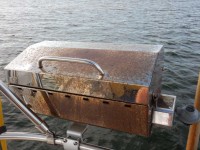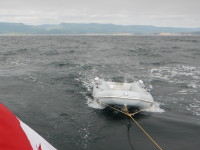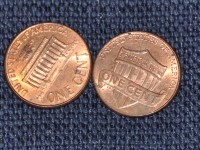There are a few great debates among sailors and anchor selection is definitely near the top of that list. So seeing as Chrissy and I have spent conservatively a couple hundred nights on anchor without dragging and have both read and compared numerous anchor tests, we thought we would share what we are leaning towards for our next anchor. Besides, surely our thoughts can’t be worse than the unsubstantiated opinions on the numerous sailing forums where the only lesson we’ve really learned is that we don’t want to anchor anywhere near 95% of those people. So, is it time to pull our big 45lb CQR of the bow as our primary anchor and if so what will we replace it?
Why if we haven’t dragged yet are we even contemplating a change from our 1933 era design CQR? And some are probably wondering why didn’t we change to a modern anchor before we left?
Well, on Georgian Bay we found the CQR anchor to work well, but we really only anchored in soft sand or mud. Any anchor can set in soft sand, and with the mud we always held if we let the anchor settle into the mud for a few minutes before we backed down to set it. I recall reading that in the late 90’s 98% of the cruising fleet was using CQRs according to an SSCA survey. And, Finally a magazine article where an author was reviewing a new Rocna basically admitted that he had been coached on good technique by the Rocna promoters, so he was making a comparison to a CQR using bad technique to a Rocna with good technique. We had also found that many anchor tests didn’t really relate to real world situations so we decided to go with what we had because it was working and figured we would save the money until we had a clearer reason to make a change.
So what have we learned since?
If you look beyond Chrissy’s beautiful painted toe nails you can see the edge of the fluke sticking up and the outline of the shank and the chain. This clearly shows that anchor is laying on its side which we saw 80% of the time. In this soft Bahamas sand the anchor had buried well enough to hold us securely but still hadn’t oriented itself upright. When the sand or bottom was harder only 1/3 of the anchor would dug in. Backing down harder just didn’t help, nor did longer or shorter scopes while setting it. We just don’t believe the anchor shape is conducive to applying the chain force to dig the anchor in further in harder bottoms.

The big ‘benefit’ to the CQR design is supposed to be the hinge to prevent pulling out when the wind shifts. But in our cruising experience this benefit doesn’t exist 80% of the time as the anchor is on its side (so the hinge would pivot up and down instead of side to side).
The CQR was also stubborn to impossible to get to penetrate the surface when there was sea grass. This was so frustrating at times in the Virgin Islands that I was seriously considering finding a grinder to attempt to sharpen the point. Instead, while we were near a Budget Marine store we downloaded the Rocna template, fully prepared to spend the extra $100 or so that the islands pricing dictated because of how happy the cruisers we had met were with their anchors. Unfortunately, when we printed the template we discovered that the roll bar on that design wouldn’t fit with our bow pulpit, and I wasn’t prepared to make a modification to our strong bow roller, nor could we easily find parts if had wanted to.
Now we are contemplating spending a month or so ‘on the hook’ in eastern Canada with bottoms notorious for kelp and rocky bottoms that CQR anchors are not going to work well in. It is scary reading that the obsolete fisherman’s anchor was the go-to anchor for these places. I hope I don’t regret throwing back the fisherman’s anchor that pulled up in Culebra.
So what are the contenders to become our primary anchor?
First off all, we also want an anchor that sets more reliably in hard sand where our CQR struggled and ideally it will perform adequately in soft Chesapeake Bay mud in case we wind up there this fall. Otherwise, after cruising for a year my ideal setup for anchoring is very similar to the Shard’s on Distant Shores (see link: Distant Shores Ideal Anchor Setup) and their views are similar to other experienced cruisers. Namely, I want a big anchor that sets reliably and is big enough to hold the boat in almost anything except a big storm. I don’t want to be fussing with a second anchor just because we are in for a squally night with 30-40 knot gusts. I also don’t really want to modify my bow roller so that rules out the roll bar variants for now. The contenders that have some appeal are the older Bruce style (claw or Manson Ray), the Spade, the Ultra and new Rocna Vulcan. Several of these are even evaluated in the February 2013 issue of Practical Sailor which had one of the more useful anchor tests we’ve come across (for those that are subscribers here is the link: Anchor test).
I’ve long been interested in the Bruce style anchors as they reportedly set in most bottoms and usually in a reasonably short distance. Serious long distance cruisers like Beth and Evans used one through multiple circumnavigations, both high and low latitudes with great reviews. The design pitfall is they have a small surface area that buries so their ultimate holding power is less than other designs. This requires a heavier model to be selected. The second issue is that the original Bruce manufacturer closed its doors after its patent ran out because cheap copies like the ‘claw’ anchor appeared on the scene. The claw models are cast which is inferior from a strength and bending perspective (but what do I know, I only specialized in metals and welding in university). If you don’t believe me, check out this failure:
As a cruiser I’d much rather have to deal with replacing a pretzel anchor in the morning because my anchor wrapped around a large rock rather than having to abandon ship in the middle of the night while the boat gets destroyed on the rocks. Even if these cases are low likelihood events.
So, the only Bruce style contender is the 44lb Manson Ray that is not made by casting to give the strength I want. The $1100 USD price tag is a deterrent though, as I could modify the bow roller and buy a popular roll bar anchor for that cost.
If money were no concern, I would likely go with the beautiful stainless steel Ultra Anchor. Using a weighted lead tip and hollow shank it is reported to always land upright and dig right in. I was impressed when I first saw them at the Toronto boat show a couple years ago. Unfortunately they do not make an affordable galvanized version at this time. So, while this would be a great piece of highly functional boat bling, I need a lot more data before taking a mortgage out on this one.
The Spade Anchor has been around for a while, but the company producing them hasn’t pushed their distribution channels as effectively as a few of the larger names. By using a lead weighted tip it does away with the need for a roll bar. The lack of the roll bar also eliminates the one weakness of the roll bar models; plugging with grass, preventing a reset or a deep set in really grassy bottoms (although this is reportedly not a common occurrence). This aspect should be beneficial for the kelp bottoms that are prompting us to change our anchor. It performed well in the Practical Sailor test and I haven’t found a bad review on them yet. These Experienced Cruisers even reported it working well in Greenland which is much further north and reportedly kelpier than our planned itinerary. I was all set to call them on Monday to find a Canadian distributor despite the cost coming in at almost double the price of the rollbar Rocna model.
Then I remembered Rocna had launched a new model last fall, the Vulcan. It looks an awful lot like the Spade (which surprised me given how critical Rocna was of the Manson Supreme being a copy a few years back). While I would really like to see some test data (doesn’t the conventional wisdom with anchors suggest avoiding knock-offs?), I can’t help but imagine that it would perform similarly to the Ultra and the Spade. The big benefit right now is that we can source one in Halifax and the cost will be half of the Spade and a quarter of the Ultra. In other words we could have it fit our budget and definitely in time to use it….
So, after this long winded blog, you can see which way we are leaning. If anyone has any experience with either the Spade or Vulcan, we would love to hear it. For those like us that don’t want to modify a bow roller, the data I’ve found suggest that the Spade (and maybe the Vulcan) are on an equal footing to the popular Rocna and Manson Supreme roll-bar models. Maybe I can convince Practical Sailor to let me do some real world testing for them to answer this question once and for all?
And, we may have a beautiful CQR lawn ornament up for grabs in a few months.




Well, now I am fully cognizant of various anchors I will decide which one to tie to Grandads belt so he cannot get away. By the way Chrissy’s nails do look beautiful.
Hi, Jeff and Chrissy…. I shall look forward to your report on how the new Rocna works out for you!
Hi Jeff and Chrissy!
— Readers beware: This message comes from a day-sailor with no experience whatsoever in either toe-nail polish, or anchoring —
From an engineering perspective, I can see that designing the perfect anchor is a little tricky. Those requirements that it settles like a concrete bunker (in any bedding) when dropped down below, pulls out as light as a feather when it is time to move on, and takes no space nor significant load when stored on deck. :S
Making this all work well in one single product is worthy of having a hefty price tag.
From a budgetary perspective (say I did know one or two about welding and the various metal strength properties I might have picked up on some ‘silicon-valley-of-the-north-wanna-bee-area’ top class university) I would attempt to combine some of the pro’s into the mostly functional anchor already in my possession (prior to donating it to a good lawn-ornament cause).
It seems like your big issue with your CQR is a poor ability to dig in straight up. Maybe that could be addressed by spending your money on a small welding machine, which can be powered off the engine. Then you can design, create, and sail all over the world (need some good test data!) with a business cover-up!
After all (famous last words in engineering): “how hard can it be?”
Take care,
Albert.
Thanks Albert, are you volunteering to help me reconfigure my charging system to have twin high output hairpin alternators and a lithium ion battery bank so that I actually have the power to weld on board?
The reality is someone has beat me to the anchor development, and has tested it in some of the extreme locations already. Rocna and Spade (and hopefully the new Vulcan we just ordered) are about as versatile as they come. Plus they hold more force than the working load of my chain in good sea bottom conditions.
There are other systems popular with cruisers where there is more dramatic room for improvement that keep me thinking….
Would love to think about how to get you able to do some welding on-board, designing the best in class compromise anchor. …can’t really have an all-in-one being best in all scenarios.
As for the power requirements, I was more thinking of a small gas turbine engine. Good weight to power ratio and I expect it to handle relatively short bursts of high power quite well.
One small down-side…. you really won’t be making any friends attempting to operate the equipment anywhere near a good anchor spot. 😀
Wayne did extensive reading when he bought a new anchor—he went with Rocna —as did his 2 friends. That’s the Rocna with the half curve not the Vulcan. Alice
After a lot more reading and testing templates, we’ve ordered a Vulcan as it should fit without modifying the bow roller. The shape of the spade on the Vulcan is the same as the Original Rocna, so we expect similar performance.
I purchase a Vulcan 20 this spring to install on my Niagara 35. I replaced the original CQR 35 lb as I was going to spend 5 weeks anchored out in the Thousand Islands and always felt the CQR questionable on how it set. I am now on week 3 and have been very impressed with how it sets and holds the bottom. It fits perfectly on the bow and I did not have to do any modifications whatsoever which was one of the reasons I purchased it.
Your article stated all the reasons why I went with the Vulcan and having a reputable Canadian company manufacturing it also helps. Good luck with your final decision.
Thanks for the feedback, glad to hear the Vulcan is working! We also went with the Vulcan 20. Have only used it once so far but it set well on the first try. I added a small roller under the bow so that the anchor has two points of contact and it is sits very securely now. I’ll post pictures sometime. We are heading out this week for PEI, the Isles Madeleine and then Bras d’or Lakes so we be able to comment its performance soon.
Jeff, any feed back on the Vulcan now that you have had it for a season. I cruse the PNW which would be simlar to the North East Coast i imagine and am debating replacing my Delta 35 with a 20 Rocna Vulcan or a 20 Manson Supream
Chris,
Very impressed so far with the Vulcan 20. It has set quickly and held firm in sand, sand-clay-gravel mixes, and dug in through moderate weed. Haven’t had a chance to try heavy sea grass or kelp yet. The only times it hasn’t set quickly for us have been in mud. Thicker mud with a more generous scope and it has also set well, just the thin soupy Cheasapeake bay mud has been a challenge, but after letting it settle for a while it did hold us in 20 knot winds in a fairly open anchorage. I always back up slowly to straighten the chain (my target is 0.3kn on the GPS) as this was often the only way the old CQR wouldn’t hop skip and jump along. In places where we can snorkel and see the anchor it is usually deeply buried and the marks in the sea bed indicate it aligned itself and dug straight in within about a 2 feet of where it landed. I have yet to see the big long 10′ drag in the sand that we routinely saw with the CQR before it would set itself.
Thanks Jeff , very helpful information. This anchor is so new, there is very little user experience available on line. We have lots of mud bottoms here in the Pacific Northwest but I suspect none as soft as Chesapeake ( mostly soupy oyster beds here). We do have a number of rocky bottom with medium sized rock over clay. Any insight on the Vulcan in this type of bottom you care to share? I’m guessing that the Original Rocna , with its sharp, thin fluke would do better in this type of bottom, but the Vulcan would preform better in mud….
Chris,
I think both the original Rocna and the new Vulcan will perform similarly in most bottoms. Sure each will perform slightly better or worse depending what it lands on. The Vulcan has the same weighted tip concept as the Spade and people speak very highly of the Spade. The Vulcan was readily available in Canada on short notice while the Spade was not, so given the similarities to the original Rocnanand the Spade I felt it was a low risk that I would be dissatisfied. No Regrets. Jeff